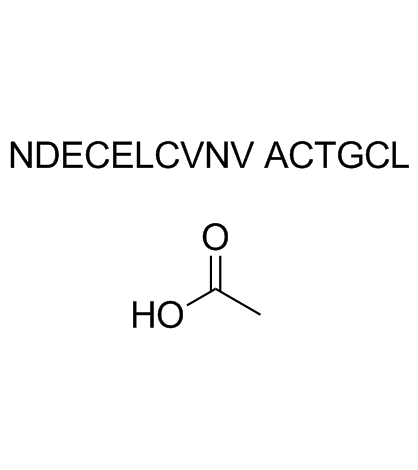1075732-84-1
| Name | Plecanatide acetate |
|---|
| Description | Plecanatide acetate is a guanylate cyclase-C (GC-C) receptor agonist, with an EC50 of 190 nM in T84 cells. Plecanatide acetate shows anti-inflammatory activity in models of murine colitis[1]. |
|---|---|
| Related Catalog | |
| Target |
EC50: 190 nM (guanylate cyclase-C receptor, T84 cells)[1] |
| In Vitro | Plecanatide acetate is a GC-C receptor agonist, binds and activates GC-C receptor, with an EC50 of 190 nM in T84 cells[1]. |
| In Vivo | Plecanatide (0.5 and 2.5 mg/kg, p.o.) ameliorates spontaneous and chemically induced colitis after treatment for 7 days in BALB/c mice, and 14 days in TCRα-/- mice[1]. Plecanatide (0.005-5 mg/kg, once daily for 7 days) also shows anti-inflammatory activity in dextran sulfate sodium (DSS) and trinitrobenzene sulfonic (TNBS)-induced colitis in BDF-1 mice[1]. Animal Model: Female BALB/c mice (2-4 month old)[1] Dosage: 0.5 and 2.5 mg/kg Administration: P.O. for 7 days, with the first dose given the same day as TNBS Result: Effectively reduced colitis severity scores in BALB/c mice. Animal Model: BDF-1 mice (10-12 week old)[1] Dosage: 0.005-5 mg/kg Administration: P.O. once daily for 7 days Result: Effective at 0.005 mg/kg as sulfasalazine (80 mg/kg) to ameliorate DSS induced colitis in BDF-1 mice, but had no incremental effect on the amelioration of colitis at higher doses than 0.005 mg/kg. Plecanatide at 0.05 mg/kg per day was as effective as 80 mg/kg per day of sulfasalazine. Animal Model: TCRα-/- mice (sixteen week old)[1] Dosage: 0.5 or 2.5 mg/kg Administration: P.O. for 14 days Result: Reduced colitis scores in TCRα-/- mice. |
| References |
| Molecular Formula | C67H108N18O28S4 |
|---|---|
| Molecular Weight | 1741.94 |
| Storage condition | 2-8℃ |
